Give meatball night a Spanish-style twist with this simple recipe! Juicy, tender, and aromatic, these Spanish Meatballs also called albóndigas simmer in a brothy sauce spiked with white wine, parsley, saffron, and almonds.
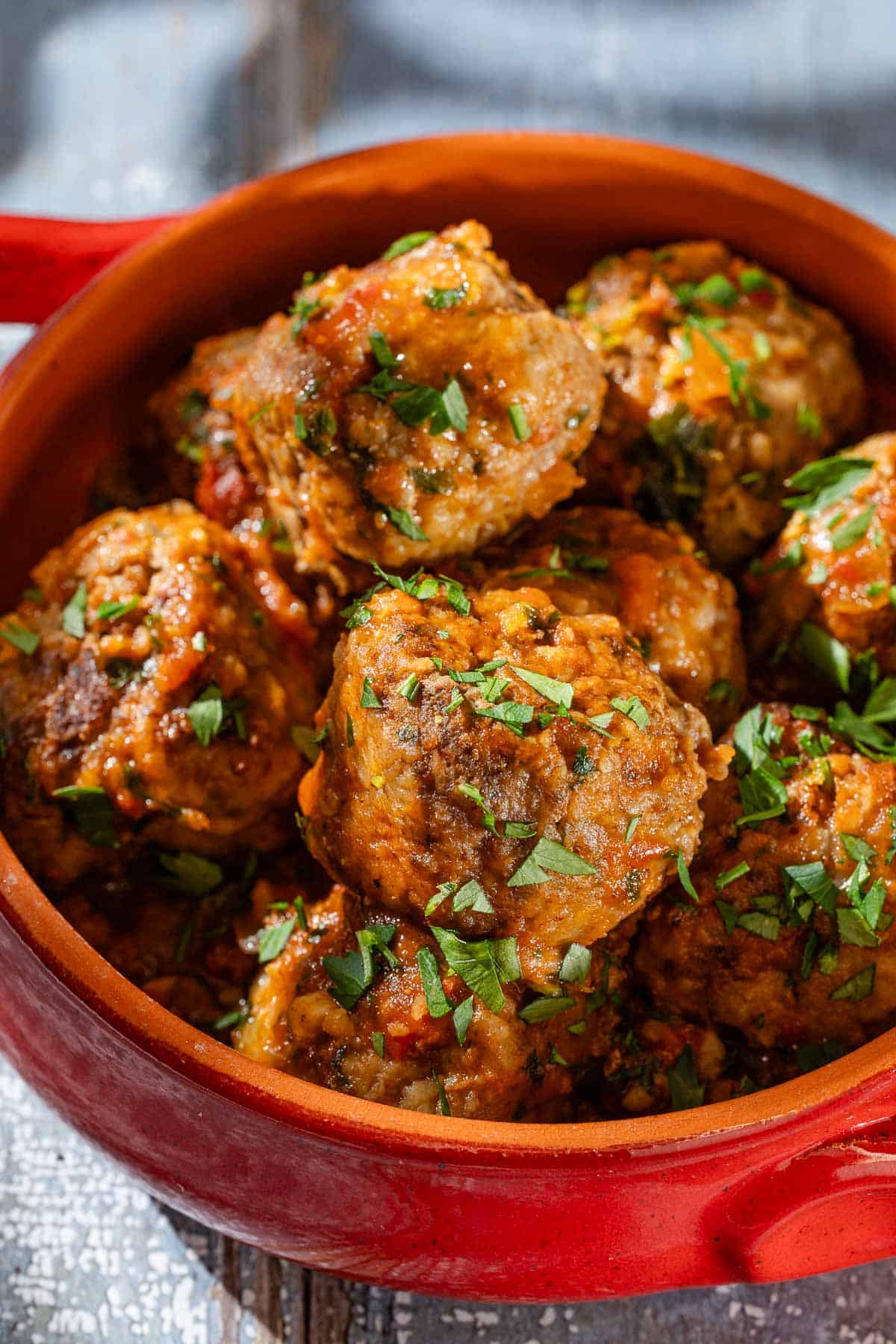
When I first arrived in Barcelona years ago, I lived in a homestay with an elderly couple, Maria and Josep. Each night, Maria would cook us a three-course dinner. She had a rotation of dishes she’d cooked for decades, her hands working by muscle memory: Stuffed Tomatoes or eggplant, orange duck, and these albóndigas or Spanish meatballs.
These meals quickly became a comfort food for me as I adjusted to life in the Mediterranean. I often watched or helped her cook so I could learn how to make them on my own. The meatballs in particular have been my favorite since leaving their apartment. Together with Maria’s sauce, they’re unctuous, savory, and comforting. As a university student, I’d make a large batch to eat after class with steamed Brown Rice throughout the week.
The albóndigas are simply seasoned with garlic, onion, and parsley, but because of the milk-soaked bread, they’re soft and tender. Meatballs are served with a tomato sauce in many parts of Spain. In Catalonia, they simmer in a rich sauce made with chicken stock that’s thickened with picada, a Catalan paste made with fresh parsley, aromatic saffron, and toasted almonds.
Table of Contents
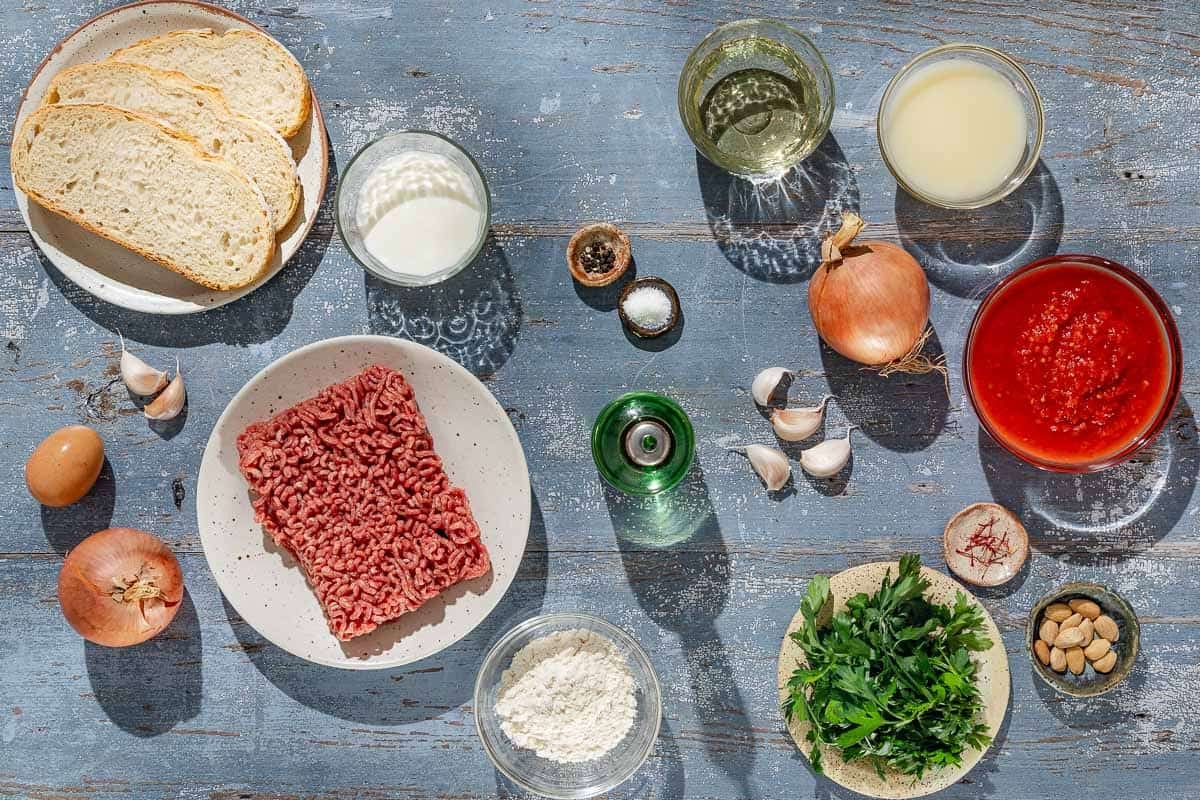
Albóndigas (Spanish Meatball) Ingredients
These meatballs have comforting Spanish flavors from easy-to-find ingredients and an aromatic boost from saffron, garlic, and parsley. Here’s what you’ll need:
For the Meatballs
- Bread: Soaking bread in milk, called a panade, adds lots of moisture to the meatballs and a lighter texture. Historically, it also helped expensive meat go further.
- Milk: Softens the bread to make the panade. I use whole milk, but 2% will also work.
- Ground beef: I use 85% to 90% lean beef. The panade prevents tough meatballs even when using leaner beef.
- Onion: I grate the onion through the largest holes on a box grater over a bowl or plate. The small pieces prevent the meatballs from falling apart like larger pieces of onion would. I add everything, the grated onion, pulp, and juice.
- Garlic: Adds a sweet and aromatic flavor to the meatballs.
- Egg: Helps bind the meatball mixture together.
- Parsley: Flat leaf parsley adds a fresh, herbaceous flavor.
- Olive oil: I use olive oil to brown the meatballs and prevent them from sticking to the pan. After browning the meatballs I drain some of the oil and use the rest for the sauce.
- RECOMMENDED FOR THIS RECIPE: Peppery Spanish Hojiblanca
- All purpose flour: The meatball mixture is soft and can stick to the pan. I prefer to coat the meatballs with flour before browning them to prevent them from sticking. The flour also helps thicken the sauce.
- Salt and pepper: Enhance the flavor.
For the Sauce
- Onion, garlic, and tomato: Together they make a sofrito, the aromatic base of the sauce.
- White wine: Dry white wine adds acidity and complexity to the sauce. To make it alcohol-free, substitute with more chicken stock.
- Chicken stock: Adds richness and flavor in the sauce. You can make your own or use a low-sodium store bought option.
- Parsley, almonds, and saffron: These are finely chopped in a food processor to form the picada, a Catalan flavor-enhancer and sauce thickener.
- Salt and pepper: Bring out the flavors in the sauce.
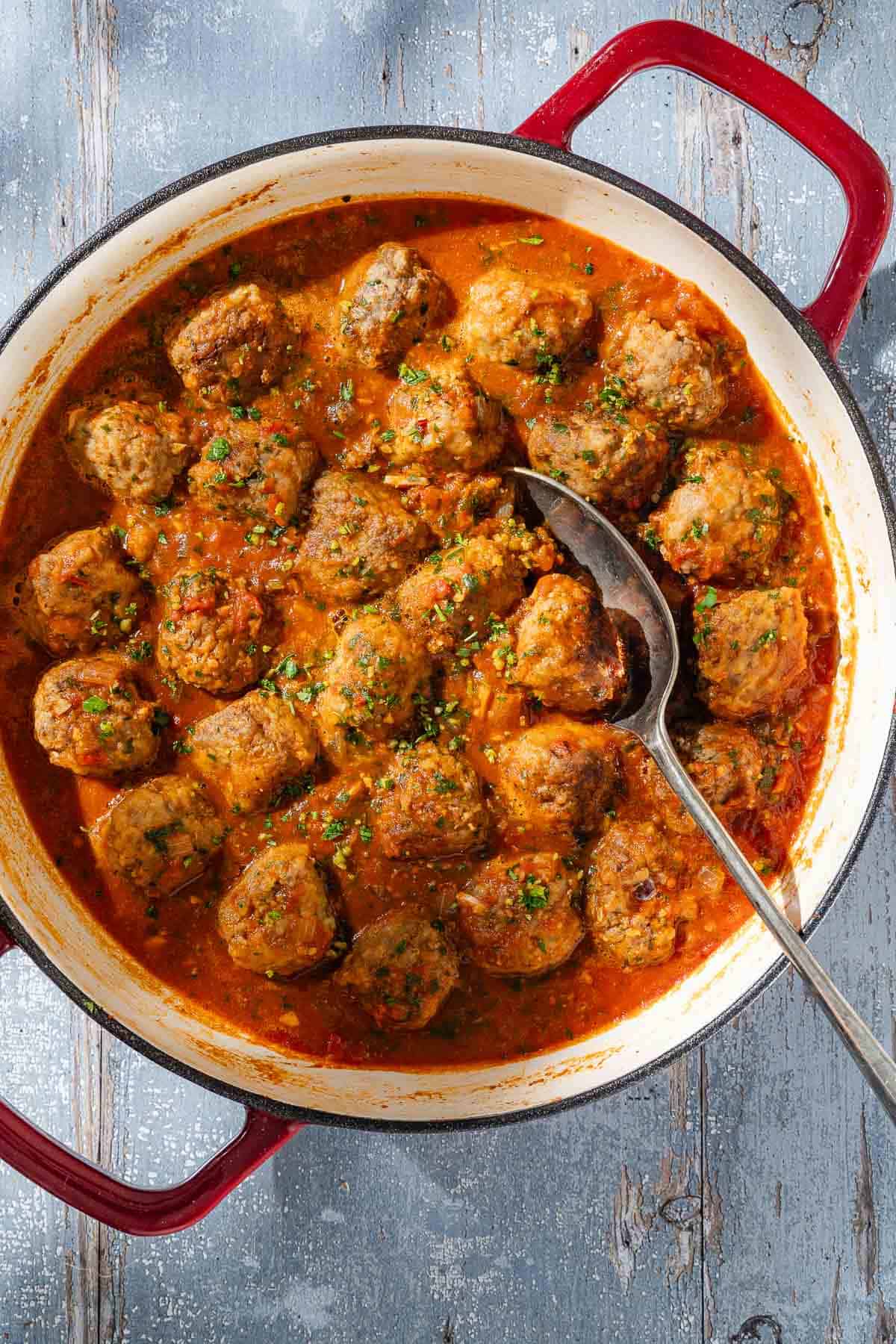
What is a Picada?
Picada is a traditional Catalan technique for flavoring and thickening a sauce or stew. While it can be made from other ingredients, it’s usually a blend of almonds, parsley, saffron, and garlic that’s ground in a mortar and pestle.
I usually skip the mortar and pestle and pulse everything in a food processor until they’re very finely chopped. In this recipe, I skipped the garlic because I added the garlic to the sofrito instead.
I was surprised the first time I tried the technique how nicely it thickened the sauce. Because it’s added at the end of cooking, the parsley doesn’t lose its fresh, green flavor. In most recipes, I steep the saffron in hot water or broth to extract the most flavor, but using it in the picada adds a more subtle bitterness and complexity to the sauce.
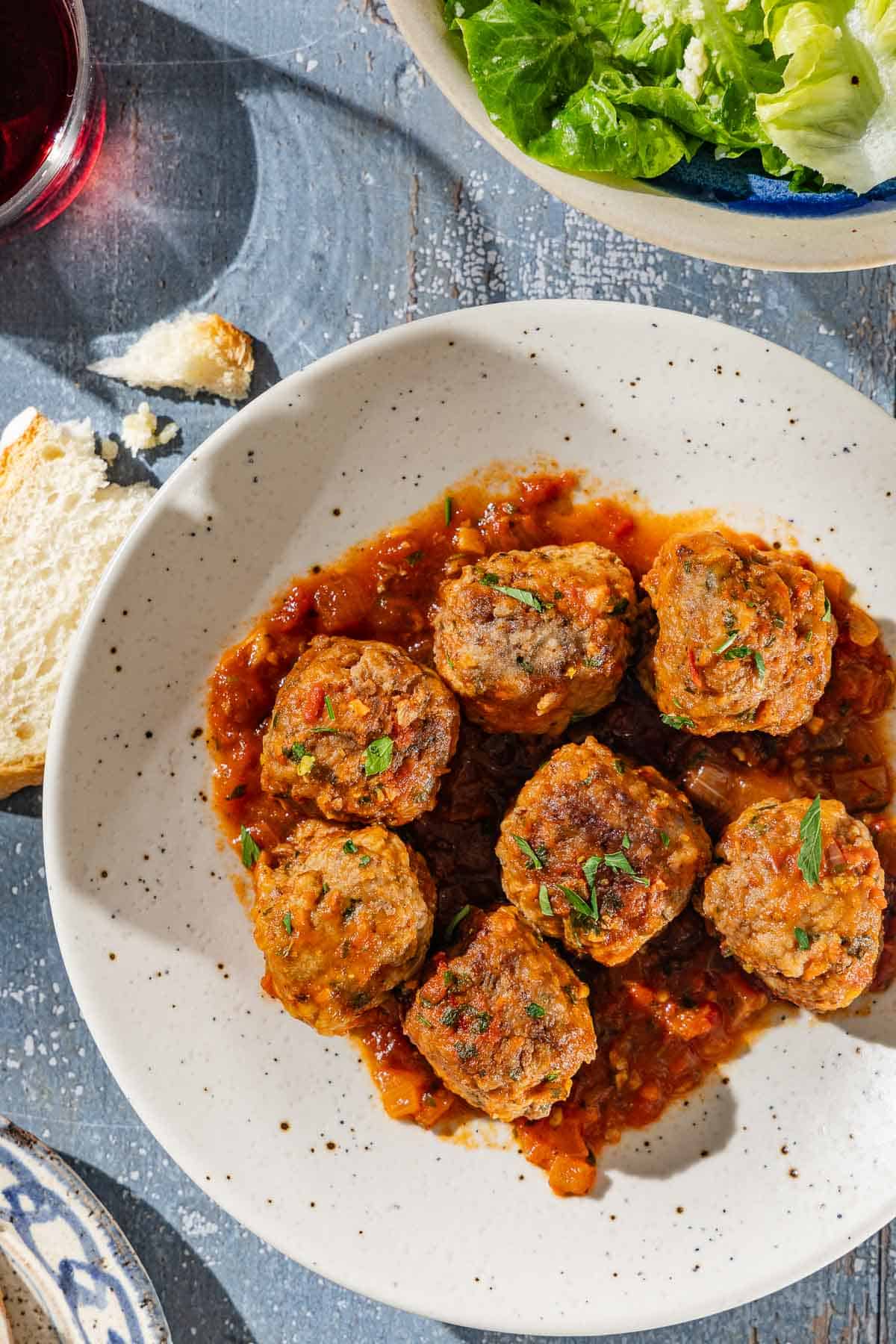
How to Make Albóndigas (Spanish Meatballs)
These meatballs take just over an hour and cook in one pan on the stovetop. Brown the meatballs and set them on a paper towel-lined plate to drain while you make the flavorful sauce in the same pan. Here’s how to make them:
Make the Albóndigas (Spanish Meatballs)
- Soak the bread. Tear 3 slices of white bread into small pieces and add them to a large mixing bowl. Pour 1/2 cup milk over the bread and let it soak for 5 minutes, then give the mixture a stir to form a paste.
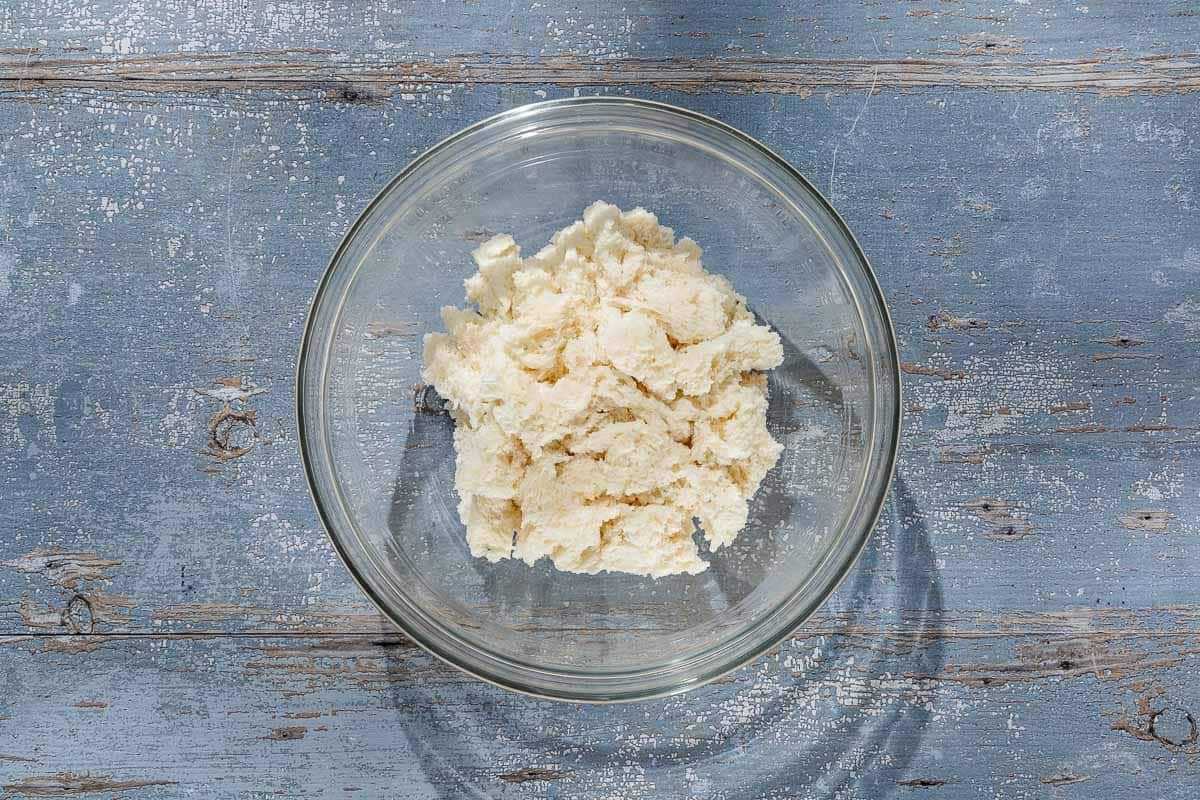
- Meanwhile, prep the aromatics. Grate 1 yellow onion into a shallow bowl to reserve its juice. Mince 2 garlic cloves. Ready yourself 1/4 cup chopped parsley.
- Make the meatball mixture. To the bowl with the bread mixture, add the onion and its juice, garlic, parsley, 1 1/2 pounds ground beef, and 1 large egg. Season with 1 teaspoon kosher salt and a generous grind of black pepper. Gently mix by hand until everything is combined. The mixture will be soft.
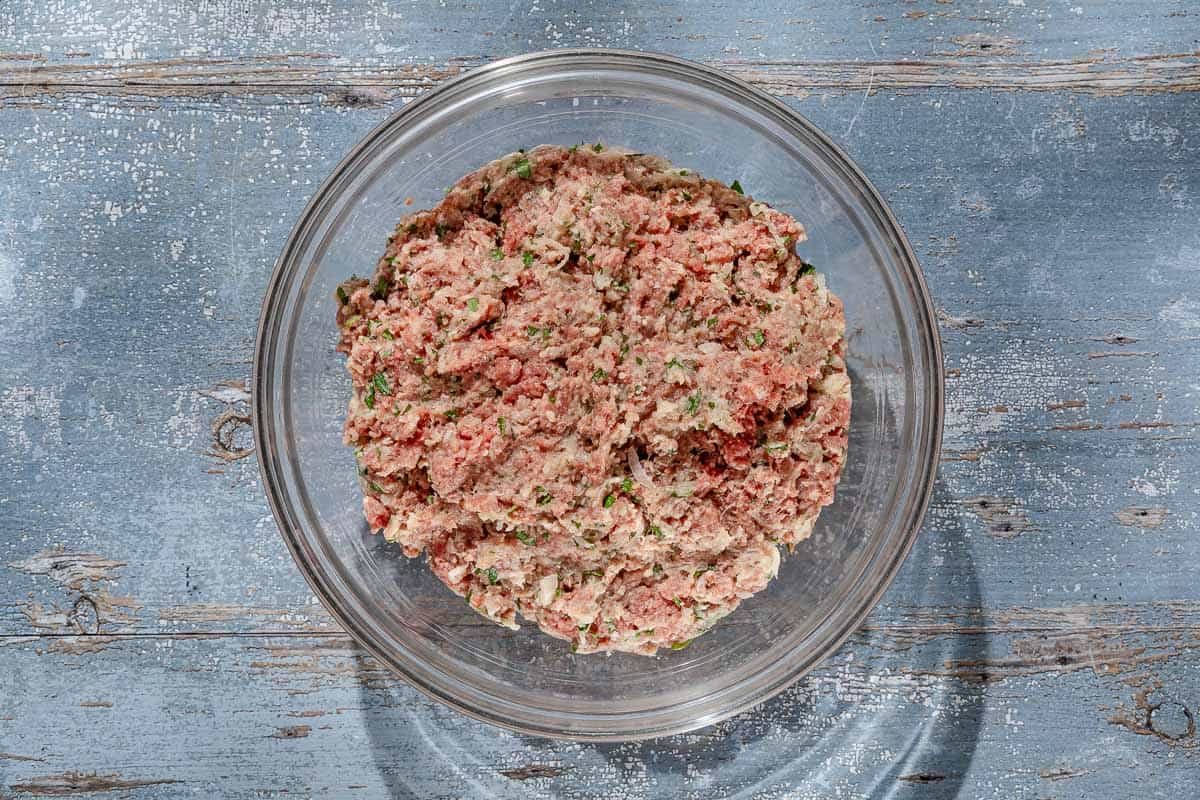
- Roll the meatballs. Portion the meatballs with a 1-ounce cookie scoop, or 2 tablespoons. Roll them in the palms of your hands to shape them into balls about the size of a golf ball. Place each meatball on a baking sheet and repeat with the remaining mixture, making about 28 meatballs.
- Sprinkle the flour over the meatballs and roll them to coat. This helps prevent them from sticking and falling apart while frying. Set them in your refrigerator while you prepare the remaining ingredients.
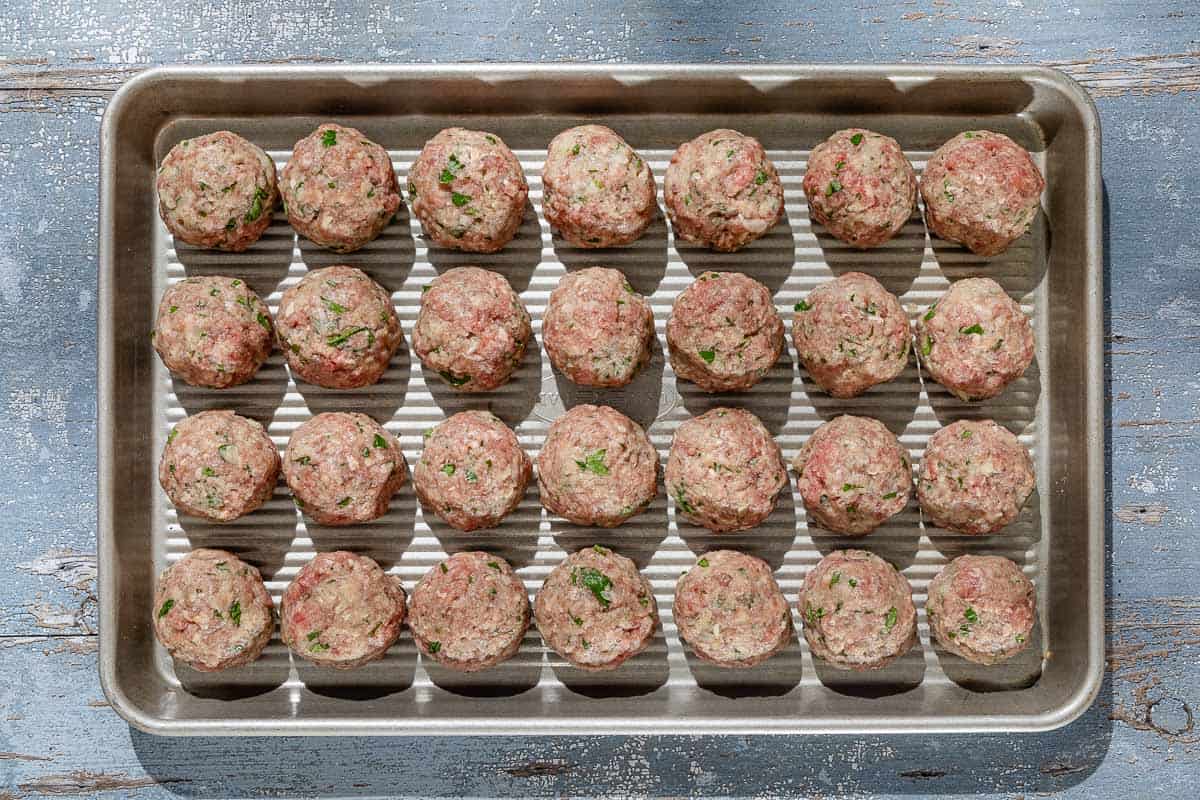
Sear, then Simmer
- Get the sauce aromatics ready. Finely chop 1 yellow onion. Mince 4 garlic cloves. Ready yourself 1/4 cup fresh parsley.
- Fry the meatballs. Heat 1/4 cup olive oil in a large skillet over medium-high. Line a large plate with paper towels and set near your stove. Once the oil is hot, add half the meatballs and cook, turning occasionally, until browned all over, about 10 minutes. Drain the seared meatballs on the paper towel-lined plate. Repeat with the remaining meatballs.
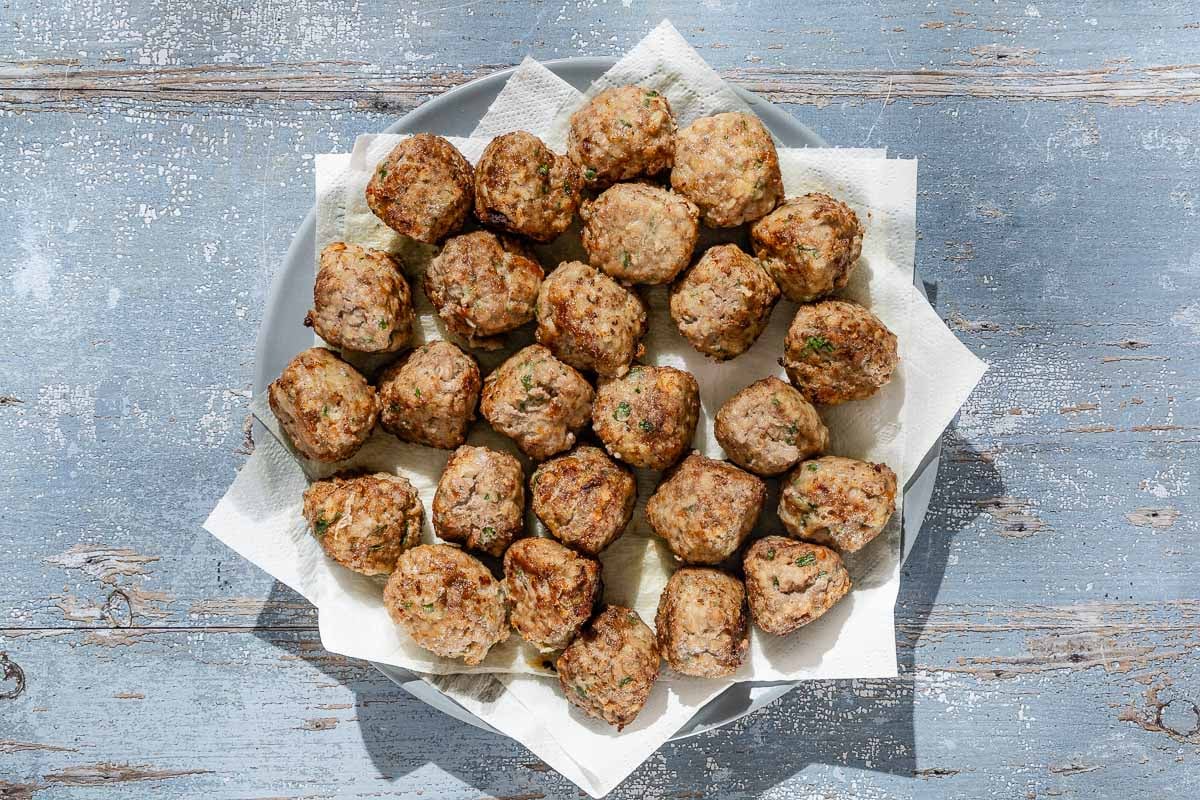
- Drain the pan. Carefully discard all but 2 tablespoons of the fat from the pan. Keep any browned bits stuck to the pan to add flavor to the sauce, but remove any larger black pieces. Return the pan to medium-high heat.
- Make the sofrito. Add the onions and sauté until softened and beginning to caramelize, about 5 minutes. Add the garlic and sauté just until softened, about 1 minute. Pour in 1 cup canned crushed tomatoes and season with 1/2 teaspoon salt. Cook until the tomato reduces and the pan is almost dry, about 5 minutes.
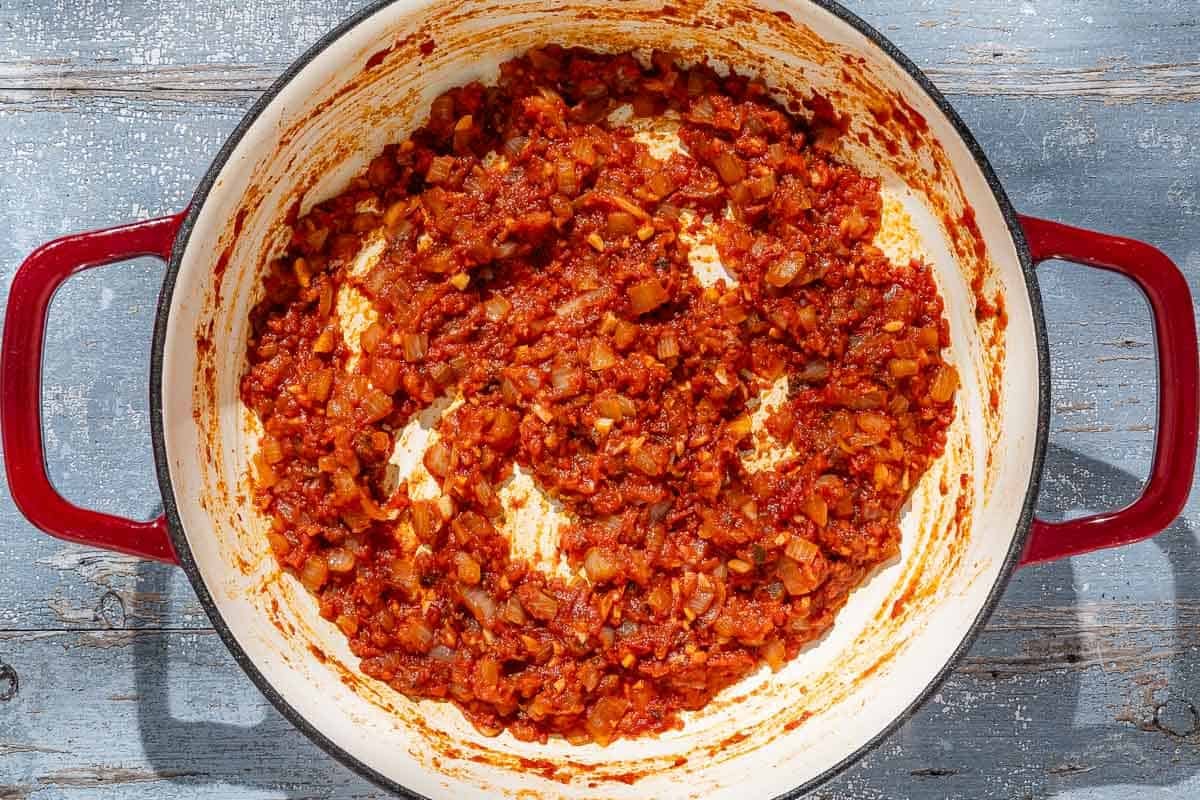
- While the tomato reduces, make the picada. Pulse the parsley, 1 tablespoon roasted unsalted almonds, and a pinch of saffron in a food processor with the blade attachment until very finely chopped, but not quite a paste.
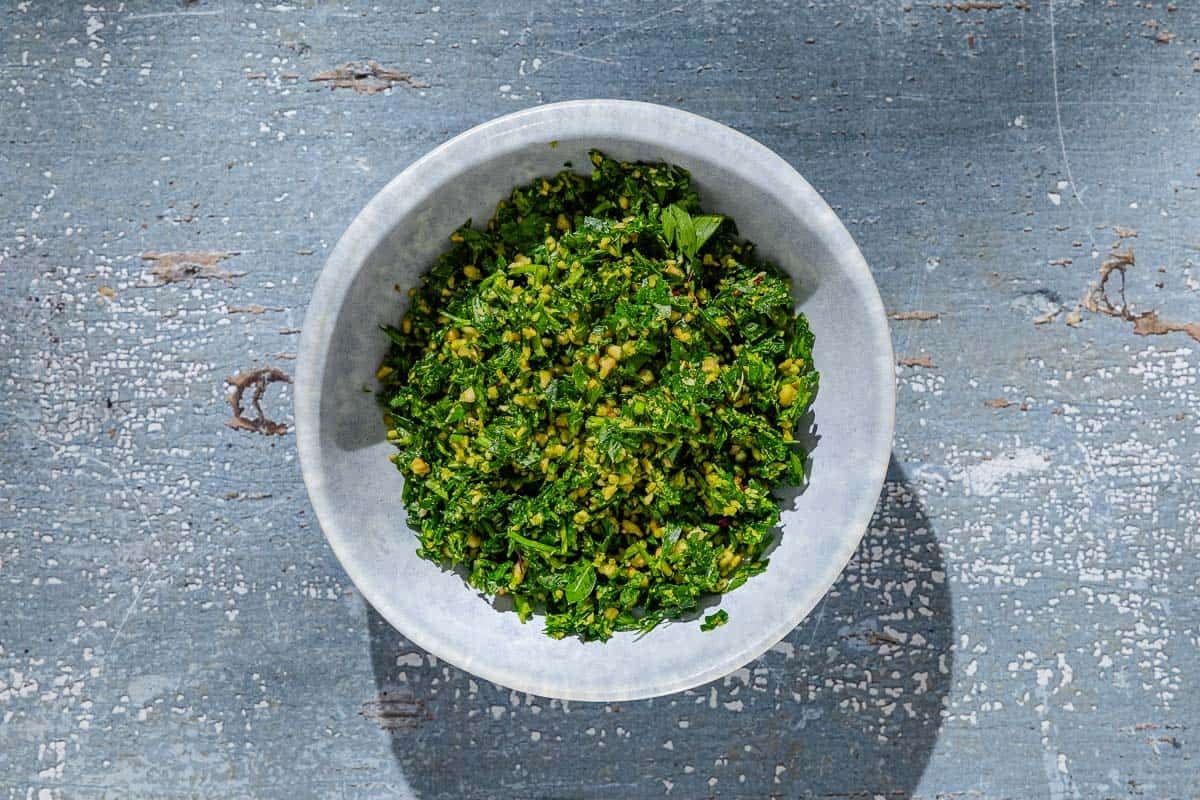
- Finish the sauce. Pour 1/2 cup white wine and 1 cup chicken stock into the sofrito and stir to combine. Nestle in the meatballs in a single layer. Sprinkle the picada into the sauce and gently swirl the pan to mix slightly. Reduce the heat to medium and let the meatballs simmer in the sauce as it thickens for 5 to 10 minutes.
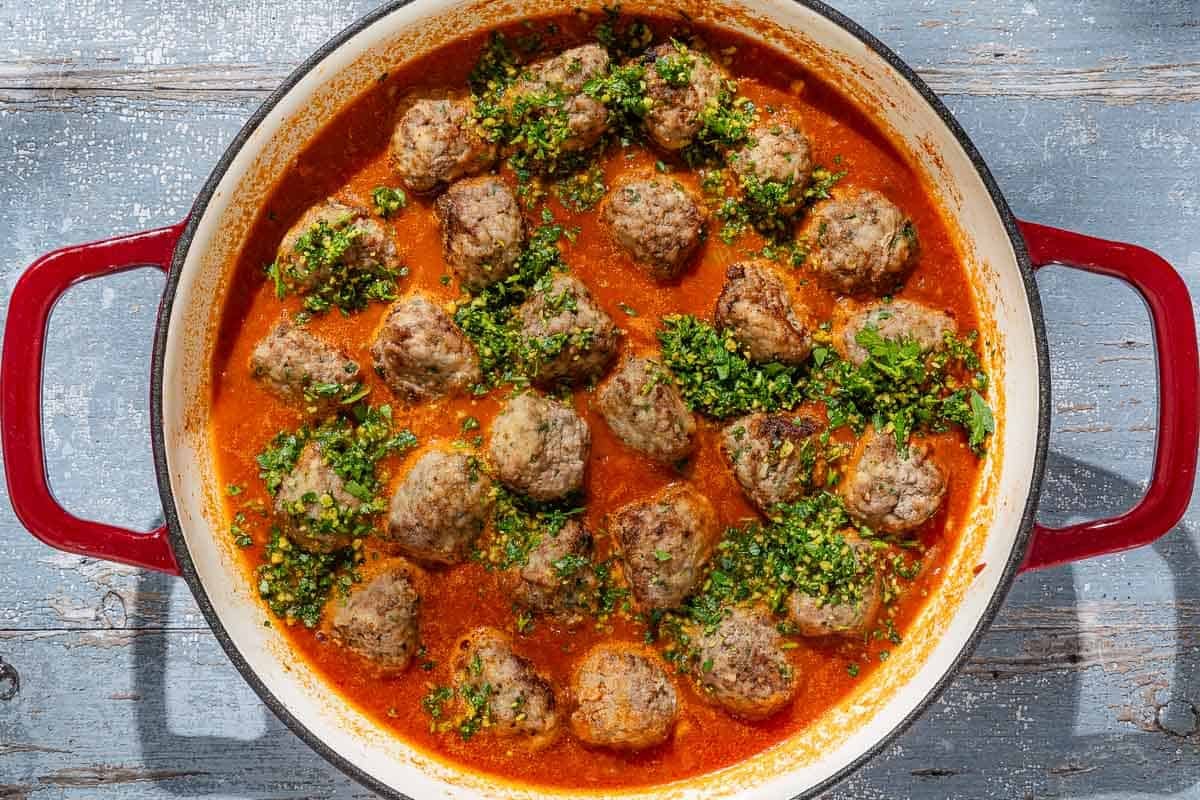
- Serve. Serve meatballs as a tapa with crusty bread for soaking up the sauce, or over steamed rice for a more substantial meal.
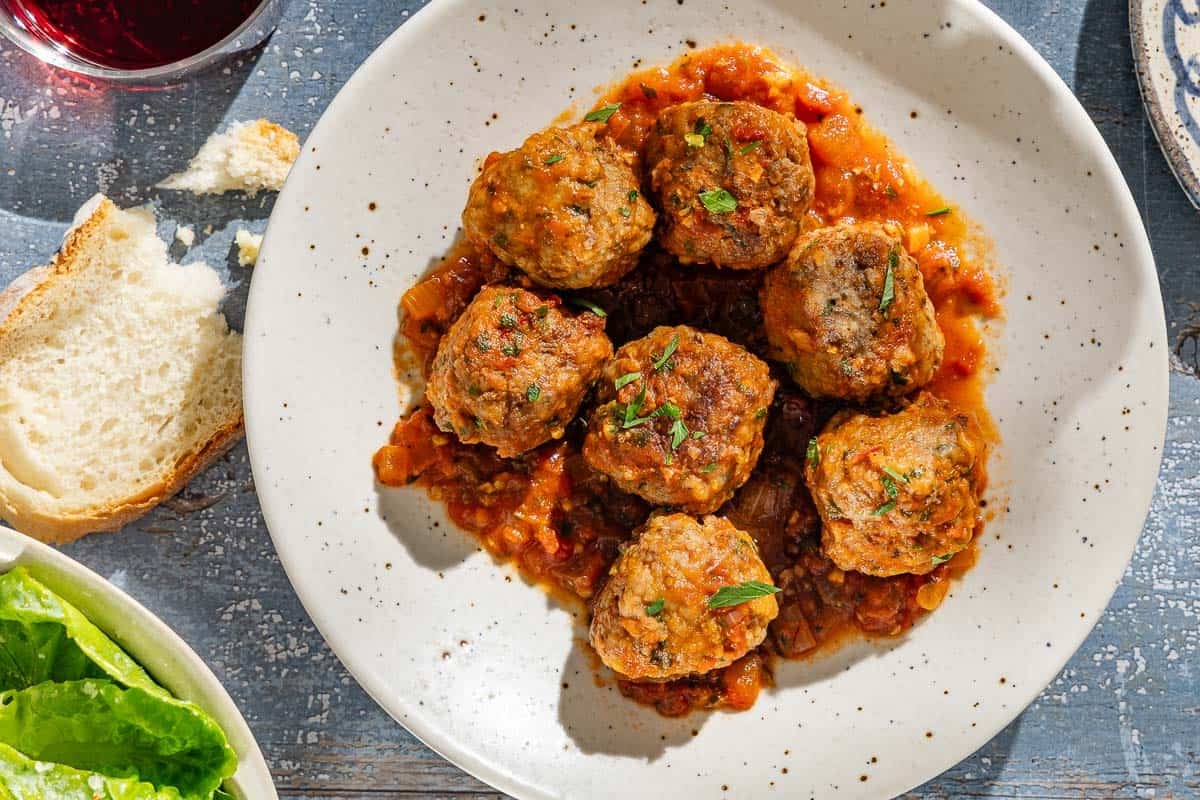
What to Serve with Spanish Meatballs
When serving the albóndigas as a tapa, I always have bread or Pan con Tomate on the side to mop up the sauce. A cold glass of Sangria or Tinto de Verano is an extra special touch if I’m having friends over.
As a meal, Spanish meatballs are usually served over rice. I prefer Brown Rice, but sometimes I make Saffron Rice for a treat. A simple side salad, like this Lemon Parmesan Lettuce Salad, makes an easy and refreshing starter.
Browse all Mediterranean recipes.
Visit Our Shop.
Albóndigas (Spanish Meatballs)

Ingredients
For the Spanish Meatballs
- 3 slices white bread (about 2 ounces), crusts removed
- 1/2 cup milk
- 1 1/2 pounds ground beef (85% to 90% lean preferred)
- 1 yellow onion, grated
- 2 garlic cloves, minced
- 1 large egg
- 1/4 cup chopped fresh parsley
- 1 teaspoon kosher salt
- Freshly ground black pepper
- All purpose flour, for coating
- 1/4 cup extra virgin olive oil
For the Catalan-Style Saffron Sauce
- 1 yellow onion, finely chopped
- 4 garlic cloves, minced
- 1 cup canned crushed tomatoes or grated fresh tomatoes
- 1/2 teaspoon salt
- 1/4 cup fresh parsley
- 1 tablespoon roasted unsalted almonds (about 10 to 12)
- 1 pinch saffron (12 to 15 threads)
- 1/2 cup white wine
- 1 cup chicken stock
Instructions
- Soak the bread. Tear the bread into small pieces into a large mixing bowl. Pour the milk over the bread and let it soak for 5 minutes, then give the mixture a stir to form a paste.
- Make the meatball mixture. To the bowl with the bread mixture, add the beef, onion and its juice, garlic, egg, parsley, salt, and a generous grind of black pepper. Gently mix by hand until everything is combined. The mixture will be soft.
- Roll the meatballs. Portion the meatballs with a 1-ounce cookie scoop, or 2 tablespoons. Roll them in the palms of your hands to shape them into balls about the size of a golf ball. Place each meatball on a baking sheet and repeat with the remaining mixture, making about 28 meatballs.
- Sprinkle the flour over the meatballs and roll them to coat. This helps prevent them from sticking and falling apart while frying.
- Fry the meatballs. Heat the olive oil in a large skillet over medium-high heat. Line a large plate with paper towels and set near your stove. Once the oil is hot, add half the meatballs and cook, turning occasionally, until browned all over, about 10 minutes. Drain the seared meatballs on the paper towel-lined plate. Repeat with the remaining meatballs.
- Drain the pan. Carefully discard all but 2 tablespoons of the fat from the pan. Keep any browned bits stuck to the pan to add flavor to the sauce, but remove any larger black pieces. Return the pan to medium-high heat.
- Make the sofrito. Add the onions and sauté until softened and beginning to caramelize, about 5 minutes. Add the garlic and sauté just until softened, about 1 minute. Pour in the tomato and salt and cook until the tomato reduces and the pan is almost dry, about 5 minutes.
- Make the picada. While the tomato reduces, make the picada. Pulse the parsley, almonds, and saffron in a food processor with the blade attachment until very finely chopped, but not quite a paste.
- Finish the sauce. Pour the wine and chicken stock into the sofrito and stir to combine. Nestle in the meatballs in a single layer. Sprinkle the picada into the sauce and gently swirl the pan to mix slightly. Reduce the heat to medium and let the meatballs simmer in the sauce as it thickens for 5 to 10 minutes.
- Serve. Serve meatballs as a tapa with crusty bread for soaking up the sauce, or over steamed rice for a more substantial meal.
Notes
Nutrition
Finish with a drizzle of Spanish Extra Virgin Olive Oil
Bold and peppery, our Spanish olive oil is harvested from 100% Hojiblanca olives.



